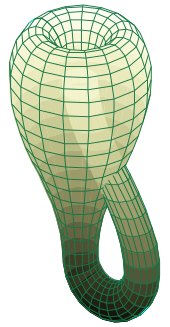
In mathematics, the Klein bottle (/ˈklaɪn/) is an example of a non-orientable surface; that is, informally, a one-sided surface which, if traveled upon, could be followed back to the point of origin while flipping the traveler upside down. More formally, the Klein bottle is a two-dimensional manifold on which one cannot define a normal vector at each point that varies continuously over the whole manifold. Other related non-orientable surfaces include the Möbius strip and the real projective plane. While a Möbius strip is a surface with a boundary, a Klein bottle has no boundary. For comparison, a sphere is an orientable surface with no boundary.
The Klein bottle was first described in 1882 by the mathematician Felix Klein.[1]
- ^ Stillwell 1993, p. 65, 1.2.3 The Klein Bottle.